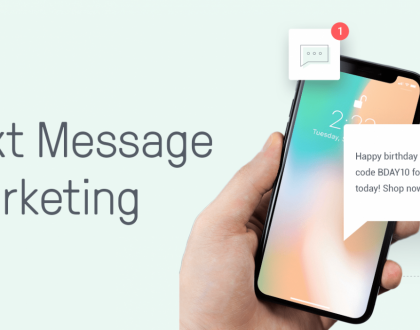How to Engage Customers With Conversational Text Messaging (And Why You Should)

A lot of the time, businesses don’t realize the importance of conversational marketing in their customer interactions and instead depend solely on traditional marketing channels like contact forms and email. By allowing your customers to reach out to you in a more personal way (such as via text messages), you can deliver better customer service and potentially increase conversion rates. In this post, we’ll take a look at how conversational marketing can help you better engage customers and gently nudge them down your sales and marketing funnel. Let’s put everything into context before we begin.
What Is Conversational Marketing?
In its simplest form, conversational marketing is all about creating one-on-one personal conversations across multiple platforms in a way that allows customers to reach out to you however, whenever, and wherever they want.
Conversational marketing happens on live chat platforms, via SMS messages, over phone calls, and in email. Basically, wherever your customers are, you’re there too!
Here are some of the main reasons why businesses should consider adopting a conversational marketing approach:
- Makes it easier for customers to get answers. Customers spend lots of time researching products before they decide to buy. Much of this time is spent reading reviews, FAQs, and trying to answer questions they have about the product. Conversational marketing allows customers to quickly get answers to their questions without having to weed through information that’s not relevant to them.
- Learn more about your customers. Through conversational marketing, you’re able to let customers tell you about their experience with your brand in their own words. This also allows you to collect customer data and feedback at scale. As a result, businesses are able to make informed decisions and deliver personalized user experiences.
- Helps foster better customer relationships. Since conversational marketing channels (like text messages and live chat) are more informal as compared to email and phone calls, businesses are able to communicate with customers in an open and friendly way. This is a great way to build strong relationships and cultivate trust.
Let’s look at the key differences between traditional marketing vs conversational marketing:
- Blasting out messages vs starting a conversation. With some traditional marketing channels, you’re essentially blasting the same message to all customers whereas with conversational marketing you’re starting conversations on a more personal level.
- One-way communication channel vs two-way communication channel. With traditional marketing, you’re simply trying to get your message seen but with conversational marketing, you’re able to establish a two-way communication channel to engage customers.
- Getting information across vs solving a problem. With traditional marketing, you’re simply letting customers know about your products, product-related information, and promotions. However, with conversational marketing you can ask customers directly about how you can help them. In other words, you’re solving a problem for them instead of simply throwing information their way.
Engaging Customers With a Conversational Text Messaging Strategy
To deliver a better customer experience and engage customers in conversation, you need to first understand their needs. A good first step is to make it easy for them to reach out to you.
Step #1: Replace Contact Forms With Messaging
Text messaging is a great way to start conversations with customers. It’s a platform that’s meant for having quick conversations and therefore creates more opportunities for conversation as compared to emails or contact forms.
One of the benefits of replacing contact forms with text messages is that you’re able to convert more leads as well as learn more about your customers. It also enables you to communicate with customers in a direct and engaging way.
Here are some actionable tips to help you get started:
- Let customers know how they can get in touch with you. For instance, “Text PRICING to XXXX to get more information on pricing.”.
- Display office hours on your business site so customers know when they can reach out to you via text message.
Step #2: Understand Customer Requirements Quickly
Qualifying leads collected through contact forms can take days to process. According to the Harvard Business Review, companies need to respond within five minutes of the initial contact to have the highest odds for winning a lead. Any delay can lead to a 400% drop in your chances of qualifying the lead!
You can set up your text messaging solution to recognize keywords and send replies to customers based on their queries. For example, if a customer uses the word pricing in their text message, they’re most likely interested in your products and are looking for information on pricing.
A great way to do this is to automate the follow up questions you’d typically ask in your contact forms or emails. This will allow you to start a conversation with customers over text messages and gradually identify what they’re interested in.
By replacing your contact forms with SMS messages, you’ll be able to deliver a more ‘human’ customer experience. This will also help you solve individual customer problems on-demand and optimize the lead qualification process.
Here are some actionable tips to help you get started:
- Develop context in your conversations to provide an enhanced user experience to customers. Give them an opportunity to explain their problems in their own words and follow up with them afterwards to make sure things are going smooth.
- Message personalization can help you improve audience engagement. However, to offer customer support over SMS, you need to standardize elements of conversations. For example, you might create templates for FAQs for commonly occurring problems.
Step #3: Move Leads Down the Funnel
SMS messaging is a great tool for collecting and organizing leads. A smart texting solution enables you to route messages to relevant customer support representatives or departments. As a result, you’ll be able to deliver a seamless text messaging experience to customers and lead them down your marketing (or sales) funnel at their own pace.
Text messaging lets you effectively shorten the sales cycle and improve the customer’s buying experience without coming off as too salesly. Instead, you’ll be able to gently nudge prospective customers towards make a buying decision.
Conclusion
Conversational marketing via text messaging is a great way to quickly connect with your audience, collect feedback, and deliver better (more engaging) customer experiences.
By adopting a conversational text messaging strategy, you’ll be able to establish a two-way communication channel with customers and continue the conversation once you’ve solved their problem or made a sale.
Recommended Posts

SMS delivering much more than sales for your business
November 18, 2021

What You Need To Know About Text Message Marketing
November 2, 2021

MARKETING A BUSINESS DURING CORONAVIRUS
March 14, 2020

